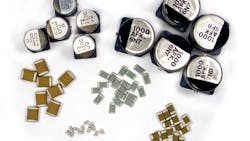Applying Ceramic Tech to Achieve High Power Density (Part 1) (Download)
Two primary characteristics of a capacitor are its energy density and power density. In Part 1 of this two-part series, we will focus on power density. Capacitor power density can be calculated as a quantity per unit volume or per unit mass.
We’ll also look at the characteristics and technology of Class I versus Class II multilayer ceramic capacitors (MLCCs) to determine which class will have the best performance for high-power-density applications. Some key applications can include snubbers, dc-link, and resonant converters.
